Hawks In Georgia
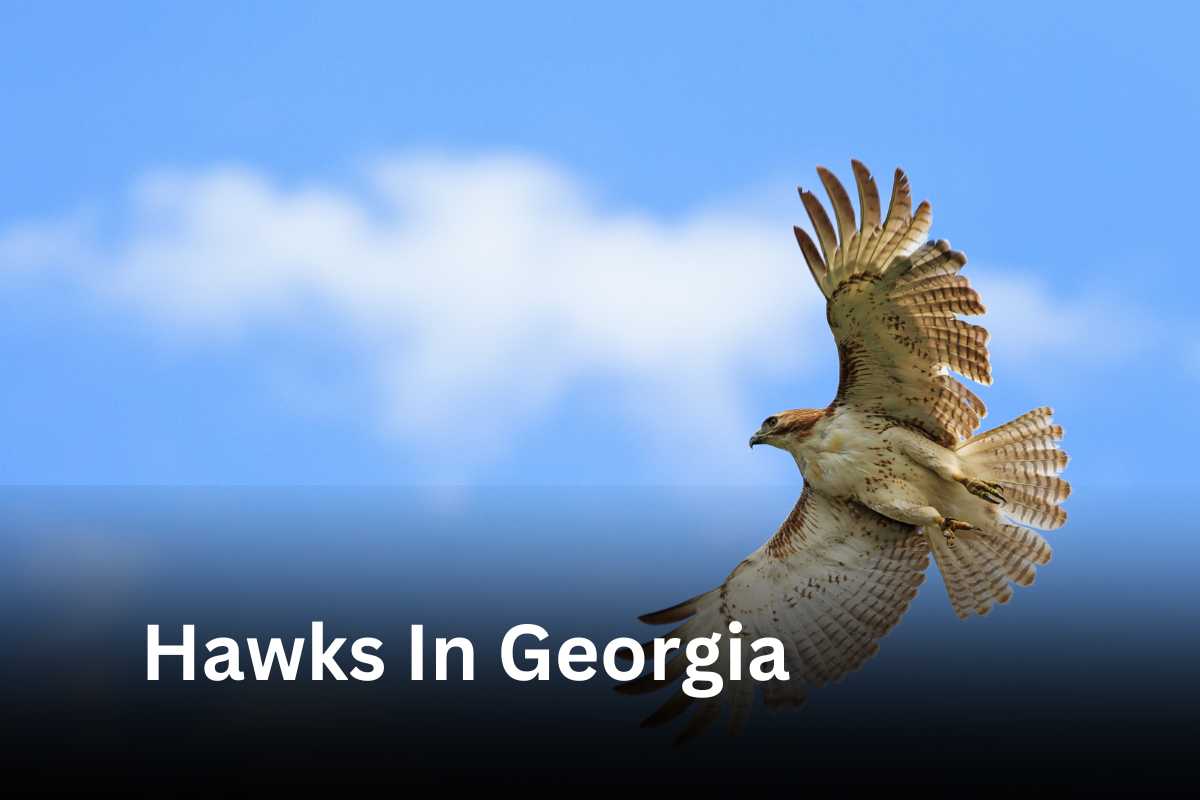
Georgia is a state that is situated in the southeastern region of the United States. According to the Records Committee of the Georgia Ornithological Society (GOSRC), there are around 424 species found in Georgia state.
From the iconic Red-tailed Hawk to the Sharp-shinned Hawk, Georgia is home to a diverse array of hawk species. Each hawk species possesses distinct physical traits, habitat, feeding, and hunting strategies.
In this blog post, we will be delving deeper into the world of the top six charismatic hawks that are commonly found in the state of Georgia. So, let us go through this article.
List Of 6 Hawks In Georgia
- Red-tailed Hawk
- Broad-winged Hawk
- Cooper’s Hawk
- Red-shouldered Hawk
- Northern Harrier
- Sharp-shinned Hawk
1. Red-tailed Hawk (Buteo jamaicensis)
One of the species of birds of prey is a Red-tailed hawk. It is the most common member in the family of Accipitridae. This species of hawk is blocky and broad in shape and its plumage is variable.
The adult red-tails physical appearance is of brown nape and upper head with a white throat. Its tail is rufous brick-red above with a variably sized. Relatively, the hawk’s bill is dark and small in size.
It forms a variable imperfect “V” on the back which is slightly darker brown. They are considered to have the largest claw on all accipitrids. The red-tailed hawk’s legs, core, and feet are yellow.
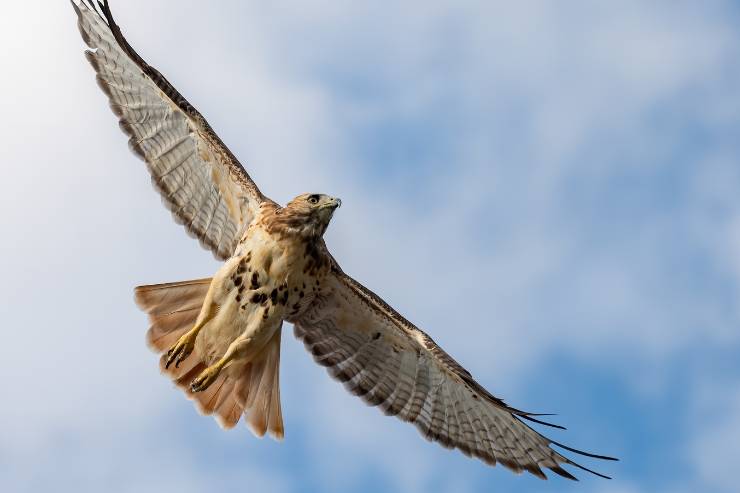
Size, Weight, Wingspan, and Lifespan of Male Red-tailed Hawk:
- Size: 18 to 24 inches (45 to 60 cm)
- Weight: 1.52 to 2.87 lbs (690 to 1,300 g)
- Wingspan: 3 ft 5 in to 4 ft 8 inches (105 to 141 cm)
- Lifespan: Upto 20 years
Size, Weight, Wingspan, and Lifespan of Female Red-tailed Hawk:
- Size: 19 to 26 inches (48 to 65 cm)
- Weight: 1.766 to 3.799 lbs (801 to 1,723 g)
- Wingspan: 4 ft 10 inches (147 cm)
In 2011, the oldest wild Red-tailed Hawk was found in Michigan which recorded its lifespan for at least 30 years and eight months old.
As per the International Union for the Conservation of Nature (IUCN), the red-tailed hawks’ status is of the least concern.
Habitat: In America, the red-tailed hawks are the most widely distributed of all raptors. During the winter, their breeding habitat ranges from southern Canada.
Throughout the year, they can be easily spotted in Georgia, North America, the interior of Alaska, northern Canada, Panama, and the West Indies. In the United States of America, it is also called the chickenhawk.
Primarily, this hawk prefers to live in large wooded edges, mixed forests, and fields, near coastal or wetlands, deserts, tropical rainforests, foothills, urban areas, and deciduous woodlands.
Feeding: The red-tailed hawk is a highly opportunistic feeder who eats other animals, called carnivores. While catching their prey, these hawks use perch hunting which is the most successful hunting method.
Their diet comprises small mammals (such as lagomorphs, voles, rats, rabbits, and rodents), reptiles, invertebrates, amphibians, and birds.
2. Broad-winged Hawk (Buteo platypterus)
The broad-winged hawk is a medium-sized hawk belonging to the family of Accipitridae. Relatively, the female broad-winged hawks are slightly larger as compared to male broad-winged hawks.
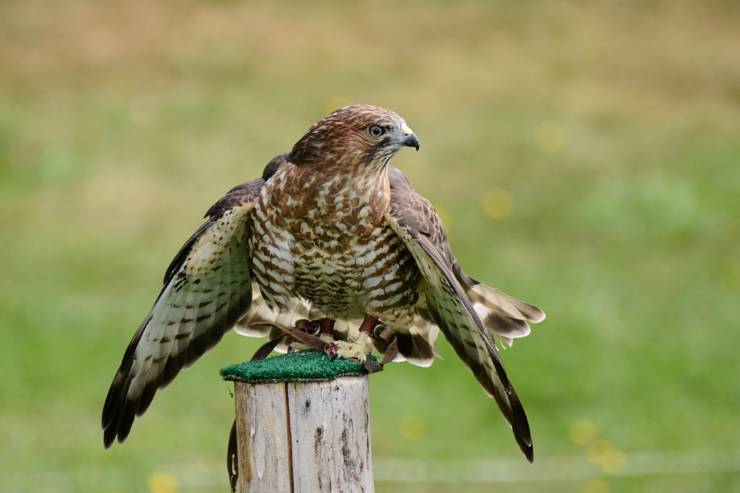
They have a unique appearance i.e. tapered. It also has a short broad wings which are quite pointed at the end. The adults have a dark brown color with a white belly and chest that has a horizontal barring. It shows two types of coloration.
Firstly, the broad-winged hawk displays a dark morph with fewer white areas. Whereas, the other color reflects as a light morph that is more pale overall.
Size, Weight, Wingspan, and Lifespan of Broad-winged Hawk:
- Size: 13 to 17 inches (32 to 44 cm)
- Weight: 9.3 to 19.8 ounces (265 to 560 g)
- Wingspan: 29 to 39 inches (74 to 100 cm)
- Lifespan: 12 years
According to the International Union for the Conservation of Nature (IUCN), the broad-winged hawk conservation status is the least concern. The population of this hawk has declined over time due to forest fragmentation.
Habitat: This hawk is often found in dense, deciduous forests or mixed coniferous forests. It forages in meadows and wetlands. Mostly the broad-winged hawk ranges from the northern, and eastern parts of North America.
Commonly, it migrates to southern Mexico, Florida, and Southern Brazil. It is a home for a wide variety of hawks that can be observed throughout the year in Georgia. Among them, one of the species of hawk is a broad-winged hawk.
Feeding: Typically, their diet consists of reptiles, amphibians, birds, mammals, and insects. The broad-winged hawks are carnivores.
Parents and chicks eat small animals during the nesting and summer seasons. Such as voles, chipmunks, lizards, shrews, frogs, and as well as sick or injured birds.
While in the winter, they feed on insects like dragonflies, snakes, crabs, grasshoppers, earthworms, and small mammals. The broad-winged hawk rarely drinks water.
3. Cooper’s Hawk (Accipiter cooperii)
It is a medium-sized hawk that is native to the North American continent. Commonly, this species of hawk is also known as big blue darter, quail hawk, swift hawk, and flying cross.
Whereas, the upper parts of the adult and its tail are solid blue-gray. They have wedge-shaped tails, moderate legs, and toes. Relatively, it has a short robust bill.
The adults have a solid blue-gray or brown-gray on the above parts. It also has blackish-brown feathers on the above with a pale nape against its streaked rufous cheeks.
While the female cooper’s hawk has slightly more brownish or grayish on the above.
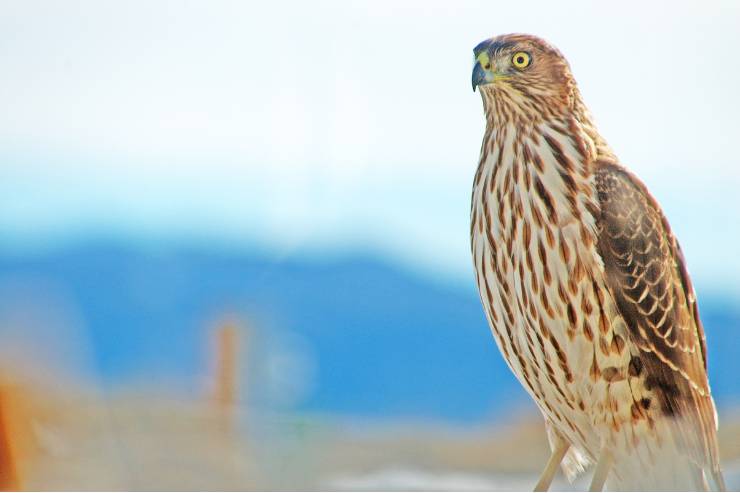
Size, Weight, Wingspan, and Lifespan of Cooper’s Hawk:
- Size: 37-39 cm (14.6-15.3 inches)
- Weight: 220-410g (7.8-14.5 oz)
- Wingspan: 62-90 cm (24.4-35.4 inches)
- Lifespan: 12 years
Habitat: It is a partial migratory hawk. The breeding habitat ranges from southern Canada to northern Mexico.
They are found in some parts of British Columbia, Ontario, Nova Scotia, the southern Great Plains, the Gulf Coast, Texas, and eastern Sonora. In winter, it can be easily seen in the southern part of Washington, Minnesota, Wisconsin, and Michigan.
Feeding: They are known as aggressive predators. Their diet comprises rabbits, quails, sparrows, and rock doves. Occasionally, they also consume frogs, fish, and insects.
4. Red-shouldered Hawk (Buteo lineatus)
The red-shouldered hawk is marked as one of the most common hawks that is a permanent resident in most parts of the United States. It is a medium-sized hawk with brownish heads and reddish chests of adults.
It also includes long tails with narrow white bars, pale bellies with reddish bars, and dark upper parts with pale spots. The wingspan of this hawk measures 94 to 110 cm.
However, the red-shouldered hawk has sometimes been confused with one of the species of hawk i.e. red-tailed hawk.
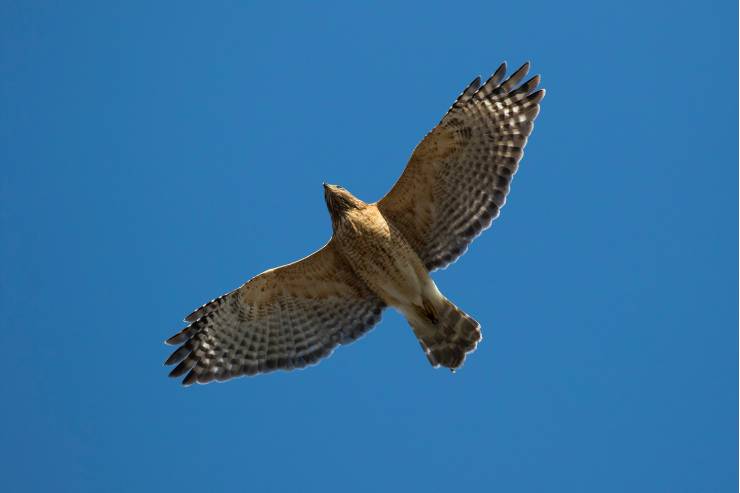
Size and Weight of Red-shouldered Hawk Male:
- Size: 15 to 23 inches (38 to 58 cm)
- Weight: 1.21 lbs (550 g)
Size and Weight of Red-shouldered Hawk Female:
- Size: 19 to 24 inches (47 to 61 cm)
- Weight: 1.5 lbs (700 g)
Commonly, one of the North American raptors, the red-shouldered hawk population is declining rapidly. This mainly results in deforestation. The average lifespan of this hawk is about 20 years.
In 2000, the oldest female red-shouldered hawk was found to be 25 years and 10 months old. It was recaptured and rereleased in California during banding operations.
Habitat: The breeding habitat of the red-shouldered hawk is in the Georgia state of United States in the north. In winter, they can be spotted easily.
While it ranges from southern New Brunswick to the eastern edge of the U.S. Great Plains, and eastern Mexico.
Preferably, they are forest raptors that can be easily observed in the flooded deciduous swamps, bottomland hardwood stands, and upland mixed forests.
Feeding: This hawk prey on small mammals like tree squirrels, rabbits, gophers, voles, chipmunks, amphibians, birds, reptiles, fish, and large insects.
Most of the red-shouldered hawk sight and attack their prey of ring-necked pheasant.
5. Northern Harrier (Circus hudsonius)
The Northern harrier is also commonly known as the ring-tailed hawk or marsh hawk. It is a bird of prey where both sexes have distinctive physical features.
In adult males, the upper part is grayish with a dark trailing edge on their wings. Relatively, it has a long-winged and long-tailed that occurs in North America.

Due to their striking plumage and spectral area, adult males are called Grey Ghosts. The plumage of male harriers is darker grey than that of females. These harriers are recognized as the aggressors pirating prey from owls.
Size, Weight, Wingspan, and Lifespan of Northern Harrier:
- Size: 16–20 inches (41–52 cm)
- Weight: 10.6-26.5 oz (300-750 g)
- Wingspan: 38–48 inches (97–122 cm)
- Lifespan: Upto 15 years
The population of the northern harrier has declined more than 30% over the last decade. So, the conservation status of this marsh hawk is classified as least concern as per the IUCN Red List.
Habitat: The northern harrier is a raptor that especially breeds on grasslands, swamps, open areas, marshes, farmland coastal prairies, moorland, and bogs.
In the state of Georgia, the northern harrier is the most common hawk. During winter, harriers migrate to the south with breeding birds in Canada, South America, Central America, and Mexico.
Additionally, these hawks can be seen all over the year in the north Atlantic states of the United States, and the Mountain West. Their breeding habitat mostly takes place in the northern hemisphere of Canada and the United States of America.
Feeding: Primarily, most of their 95% of the diet consists of small mammals. Typically, these birds often fly and hunt their prey in low flight on long wings that hold a shallow V-shape.
Its diet comprises cotton rats, ground squirrels, voles, shorebirds, young waterfowl, galliforms, orthopterans, rabbits, and adult ducks.
6. Sharp-shinned Hawk (Accipiter striatus)
This species of hawks is small in size. The sharp-shinned hawk as a raptor has short broad wings and a black medium-length tail banded with a gray tip.
In terms of flight, its feather is only visible which is of whitish barred blackish. They have a hooked bill that possesses black color, yellowish cere, and long, slender legs.
Size, Weight, and Wingspan of Male Sharp-shinned Hawk:
- Size: 9.1 to 11.8 inches (23 to 30 cm)
- Weight: 2.9–4.1 ounces (82–115 g)
- Wingspan: 17 to 23 inches (42 to 58 cm)
Size, Weight, and Wingspan of Female Sharp-shinned Hawk:
- Size: 11 to 15 inches (29 to 37 cm)
- Weight: 5.3 to 7.7 ounces (150 to 219 g)
- Wingspan: 23 to 27 inches (58 to 68 cm)
The average lifespan of the sharp-shinned hawk is more than five years. One of the most migratory raptors i.e. Sharp-shinned hawk is declining over the years due to the use of pesticides and DDT.

Now, the United States Fish and Wildlife Service has listed this hawk as endangered.
Habitat: Notably, this hawk prefers to live in a wide range of woodland and forests. Mainly it is found in the upper tropical to temperate highlands, subtropical regions (in lowlands and highlands), and altitudes.
Being the smallest hawk, the sharp-shinned hawk can be spotted in the United States (especially in Georgia) and Canada. Widely, it is spread in South America, Central America, North America, and the Greater Antilles.
Feeding: The main source of the Sharp-shinned hawk diet is small birds. This hawk especially feeds on songbirds of small size like finches, thrushes, wrens, wood warblers, sparrows, tits, and icterids.
Most of the time it has been observed that sharp-shinned hawk males target smaller birds. Similarly, the females will target the larger prey (i.e. flickers and American Robin).
Occassionally, it also preys on bats. Apart from this, they rarely eat frogs, snakes, rodents, large insects, and lizards.
Conclusion:
In conclusion, if you are a bird enthusiast or a resident of Georgia, then the presence of hawks enhances the state’s natural allure with its diverse avian heritage.
There have been several species of hawks that are commonly found in the Georgia state. This hawk has been able to garner the attention of many bird lovers with their majestic flight and impressive hunting skills.
As we all know, the population of hawks is declining rapidly in recent decades. This results due to DDT, deforestation, and the use of pesticides.
However, the conservation status of this hawk is listed as the least concern. It has been marked that the recovery of hawk populations is increasing, which indicates positive progress in their recovery.






